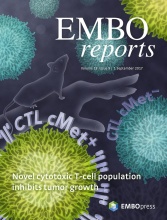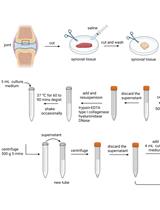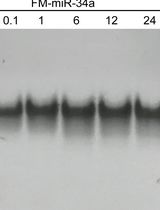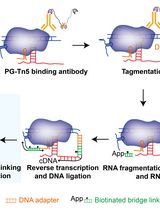- EN - English
- CN - 中文
Generation of microRNA Sponge Library
microRNA海绵文库的生成
发布: 2018年04月20日第8卷第8期 DOI: 10.21769/BioProtoc.2820 浏览次数: 7894
评审: Alka MehraAntoine de MorreeSmita Nair
Abstract
This protocol describes the generation and functional validation of microRNA (miRNA) sponge or decoy constructs. When expressed from a strong promoter, these transcripts can sequester specific miRNA:RISC complexes, thereby resulting in a derepression of endogenous target mRNA. Hence, cells expressing such sponges display a partial or full miRNA loss-of-function phenotype.
Depending on the sponge sequence, the activity of any miRNA of choice can be inhibited by sponge sequestration, but it should be noted that these constructs do not seem to be specific for one particular miRNA. Rather, all miRNAs of the same family as defined by the seed sequence will be affected, albeit to a different degree.
Background
microRNAs (miRNAs) are short, non-coding RNAs with a size of about 21-24 nucleotides that post-transcriptionally silence the majority of all protein-coding genes in mammals. Since their discovery, more and more studies have clearly identified this regulatory layer as a crucial element for almost all physiological processes. Not surprising in this context, aberrant expression of miRNAs has also been causally linked to several human malignancies including cancer.
Using classic gain-of-function approaches, early studies have often utilized overexpression to evaluate the function of a particular miRNA. However, this can reach miRNA levels up to 100-fold or higher compared to the physiological context and may generate a phenotype that is not necessarily linked to the miRNA’s normal function.
To avoid this obvious problem with possible overexpression artifacts, in the last years several techniques for miRNA inhibition have been developed both for in vitro and in vivo use, thereby allowing the analysis of a specific miRNA or a group of miRNAs in a loss-of-function approach. These include e.g., the expression of miRNA decoys or sponges, long transcripts that interfere with miRNA function by sequestering miRNA:RISC complexes in a sequence-specific manner (Ebert et al., 2007; Gentner et al., 2009). Another frequently used strategy to interfere with miRNA function are antagomirs, small antisense RNAs complementary to specific miRNAs that can be brought into cells by different means such as by transfection or by viral transduction (Krützfeldt et al., 2005; Scherr et al., 2007). Notably, antagomirs have also been modified in a way that facilitates their cellular uptake, making them an attractive therapeutic tool. More recently, CRISPR/Cas9-mediated genome editing has been shown to be able to abolish miRNA expression on the level of its gene (Chang et al., 2016).
Here I provide a detailed protocol for the generation and functional validation of microRNA sponges as recently described (Lindner et al., 2017). Compared to synthesized small RNAs such as antagomirs, miRNA sponges are cheap and can be stably expressed by retroviral integration. This allows the long-term miRNA knockdown in almost every type of cell and tissue, even in specimen that are difficult to transfect. Moreover, the expression of the sponge RNA can be linked to a fluorescent and/or genetic marker, allowing the easy tracking of sponge-positive cells e.g., by microscopy or flow cytometry. Last, miRNA sponges have been shown to sequester not single miRNAs, but rather all miRNAs of the same family as defined by their seed sequence, i.e., sponges may uncover redundant roles of miRNAs expressed in a particular tissue.
Materials and Reagents
- 1.5 ml microcentrifuge tubes (SARSTEDT, catalog number: 72.690.001 )
- PCR tubes (SARSTEDT, catalog numbers: 72.985.002 and 65.986.002 )
- Chemically competent E. coli cells (home-made or New England Biolabs, catalog number: C2987H )
- DNA oligonucleotides, reverse phase cartridge or HPLC-purified (Sigma-Aldrich, catalog number: OLIGO )
- PHUSION polymerase (New England Biolabs, catalog number: M0530 )
- Deoxynucleotide (dNTP) solution mix (Carl Roth, catalog number: K039.1 )
- TOPO PCR Cloning Kit (Thermo Fisher Scientific, InvitrogenTM, catalog number: 451245 )
- Plasmid Mini Kit (Carl Roth, catalog number: HP29.2 )
- Restriction enzymes (New England Biolabs)
- CloneJET PCR Cloning Kit (Thermo Fisher Scientific, Thermo ScientificTM, catalog number: K1231 )
- Agarose Gel Extraction Kit (Jena Bioscience, catalog number: PP-202L )
- DNA ladder (Promega, catalog number: G5711 )
- LE Agarose (Biozym Scientific, catalog number: 840004 )
- Tris base (Sigma-Aldrich, catalog number: T1503 )
- Glacial acetic acid (Sigma-Aldrich, EMD-Millipore, catalog number: 27225-M )
- EDTA, disodium salt (Sigma-Aldrich, catalog number: E5134 )
- Deionized water
- 10x TAE for DNA electrophoresis (see Recipes)
Equipment
- Pipettes (Eppendorf, model: Research® Plus, catalog numbers: 3123000918 , 3123000020 )
- PCR machine TProfessional Basic (Biometra, catalog number: 070-701 )
- Electrophoresis equipment (Bio-Rad Laboratories)
Procedure
文章信息
版权信息
© 2018 The Authors; exclusive licensee Bio-protocol LLC.
如何引用
Herzog, S. (2018). Generation of microRNA Sponge Library. Bio-protocol 8(8): e2820. DOI: 10.21769/BioProtoc.2820.
分类
分子生物学 > RNA > miRNA 干扰
分子生物学 > RNA > miRNA与mRNA 的相互作用
您对这篇实验方法有问题吗?
在此处发布您的问题,我们将邀请本文作者来回答。同时,我们会将您的问题发布到Bio-protocol Exchange,以便寻求社区成员的帮助。
提问指南
+ 问题描述
写下详细的问题描述,包括所有有助于他人回答您问题的信息(例如实验过程、条件和相关图像等)。
Share
Bluesky
X
Copy link













